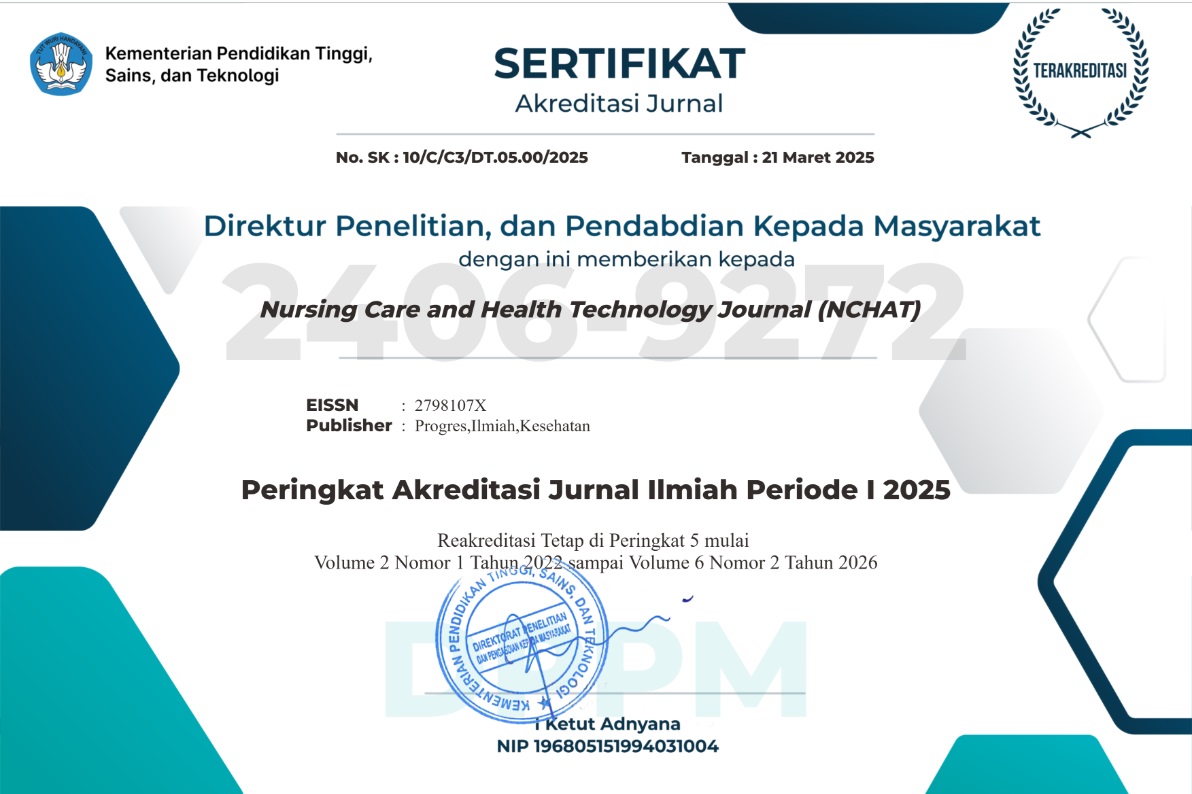Hubungan Komunikasi SBAR Saat Serah Terima dengan Kinerja Perawat Dalam Melaksanakan Asuhan Keperawatan
DOI:
https://doi.org/10.56742/nchat.v5i2.204Keywords:
Asuhan Keperawatan, Kinerja Perawat, Komunikasi SBAR, Serah TerimaAbstract
Pelayanan keperawatan memerlukan komunikasi efektif untuk menjamin kesinambungan dan keselamatan pasien, salah satunya melalui penerapan metode SBAR (Situation, Background, Assessment, Recommendation) saat serah terima (handover). Penelitian ini bertujuan untuk mengetahui hubungan antara penerapan komunikasi SBAR saat serah terima dengan kinerja perawat dalam melaksanakan asuhan keperawatan di ruang rawat inap RSU Cut Meutia Kabupaten Aceh Utara. Desain penelitian yang digunakan adalah analitik dengan pendekatan cross-sectional, melibatkan 116 perawat yang dipilih menggunakan teknik accidental sampling. Data dikumpulkan melalui kuesioner komunikasi SBAR (26 item) dan kinerja perawat (30 item) yang telah diuji validitas dan reliabilitas. Analisis dilakukan secara univariat dan bivariat dengan uji Spearman Rank pada tingkat kepercayaan 95%. Hasil menunjukkan mayoritas responden melaksanakan komunikasi SBAR secara efektif (69%) dan memiliki kinerja baik (62.9%). Uji Spearman Rank menghasilkan p-value = 0.026 dan r = 0.207 yang menunjukkan adanya hubungan signifikan dengan arah korelasi positif antara komunikasi SBAR dan kinerja perawat. Disimpulkan bahwa penerapan komunikasi SBAR yang efektif berkontribusi pada peningkatan kinerja perawat dalam asuhan keperawatan.
References
Yun J, Lee YJ, Kang K, Park J. Effectiveness of SBAR-based simulation programs for nursing students: a systematic review. BMC Med Educ. 2023;23(1):507. [View at Publisher] [Google Scholar]
Ghosh S, Ramamoorthy L, Pottakat B. Impact of structured clinical handover protocol on communication and patient satisfaction. J patient Exp. 2021;8:2374373521997733. [View at Publisher] [Google Scholar]
Wianti A, Koswara R. Description of the Implementation of Sbar Communication. Asian Community Heal Nurs Res. 2021;9. [View at Publisher] [Google Scholar]
Pun J. Factors associated with nurses’ perceptions, their communication skills and the quality of clinical handover in the Hong Kong context. BMC Nurs. 2021;20(1):95. [View at Publisher] [Google Scholar]
Lo L, Rotteau L, Shojania K. Can SBAR be implemented with high fidelity and does it improve communication between healthcare workers? A systematic review. BMJ Open. 2021;11(12):e055247. [View at Publisher] [Google Scholar]
Nurti YKG, Simamora RS, Indrawati L, Pranata A, Nuryanti L, Deniati K. Strengthening Nursing SBAR Communication Compliance to Improve Patient Safety. Malaysian J Nurs. 2025;17(1):84–93. [View at Publisher] [Google Scholar]
Sulistyawati W, Rahayu KIN, Dhanti A. Hubungan komunikasi SBAR pada saat handover dengan kinerja perawat dalam melaksanakan asuhan keperawatan di ruang rawat inap. J Ilmu Kesehat. 2020;9(1). [View at Publisher] [Google Scholar]
Alizadeh-Risani A, Mohammadkhah F, Pourhabib A, Fotokian Z, Khatooni M. Comparison of the SBAR method and modified handover model on handover quality and nurse perception in the emergency department: a quasi-experimental study. BMC Nurs. 2024;23(1):585. [View at Publisher] [Google Scholar]
Pazar B, Kavakli O, Ak EN, Erten EE. Implementation and Evaluation of the SBAR Communication Model in Nursing Handover by Pediatric Surgery Nurses. J PeriAnesthesia Nurs. 2024; [View at Publisher] [Google Scholar]
Ghonem NMES, El-Husany WA. SBAR shift report training program and its effect on nurses’ knowledge and practice and their perception of shift handoff communication. SAGE Open Nurs. 2023;9:23779608231159340. [View at Publisher] [Google Scholar]
Junça-Silva A, Menino C. How job characteristics influence healthcare workers’ happiness: A serial mediation path based on autonomous motivation and adaptive performance. Sustainability. 2022;14(21):14251. [View at Publisher] [Google Scholar]
Soed N, Ludin SM, Abdullah SNS, Al-Zahrawi R. Exploring the Impact of the SBAR on Nursing Handover: A Scoping Review. Malaysian J Nurs. 2025;17(1):233–45. [View at Publisher] [Google Scholar]
Krisnawati KMS, Yanti NPED. Gambaran pengetahuan mengenai teknik komunikasi SBAR pada perawat dalam handover. J Keperawatan. 2023;15(1):221–6. [View at Publisher] [Google Scholar]
Abbaszade A, Assarroudi A, Armat MR, Stewart JJ, Rakhshani MH, Sefidi N, et al. Evaluation of the impact of handoff based on the SBAR technique on quality of nursing care. J Nurs Care Qual. 2021;36(3):E38–43. [View at Publisher] [Google Scholar]
Provost LP, Murray SK. The health care data guide: learning from data for improvement. John Wiley & Sons; 2022. [View at Publisher] [Google Scholar]
Mulfiyanti D, Satriana A. The Correlation between the use of the SBAR Effective Communication Method and the Handover Implementation of Nurses on Patient Safety. Int J Public Heal Excell. 2022;2(1):376–80. [View at Publisher] [Google Scholar]
Saragih AML, Novieastari E. Optimalisasi Penerapan Komunikasi SBAR saat Serah Terima Pasien antar Shift Keperawatan. J Keperawatan Silampari. 2022;6(1):36–43. [View at Publisher] [Google Scholar]
Hadi M, Ariyanti T, Anwar S. The Application of The Situation, Background, Assessment, Recommendation (SBAR) Method in Nurse Handover Between Shifts in The Hospital. Indones Nurs J Educ Clin. 2020;6(1):72–9. [View at Publisher] [Google Scholar]
Wibowo HP, Basri B, Halawa A. Hubungan Supervisi Kepala Ruangan terhadap Pelaksanaan Komunikasi SBAR pada Saat Handover. J Keperawatan Prior. 2022;5(2):85–92. [View at Publisher] [Google Scholar]
Dewi VC, Sriningsih N, Winarni LM. Hubungan kepatuhan penerapan komunikasi SBAR dengan keselamatan pasien pada perawat di RSU Kabupaten Tangerang. Berk Ilm Mhs Ilmu Keperawatan Indones. 2021;9(1):39–45. [View at Publisher] [Google Scholar]
Downloads
Published
How to Cite
Issue
Section
License
Copyright (c) 2025 Miftahul Zannah, Fauziah, Syamsul Bahri, Fitriani

This work is licensed under a Creative Commons Attribution 4.0 International License.










